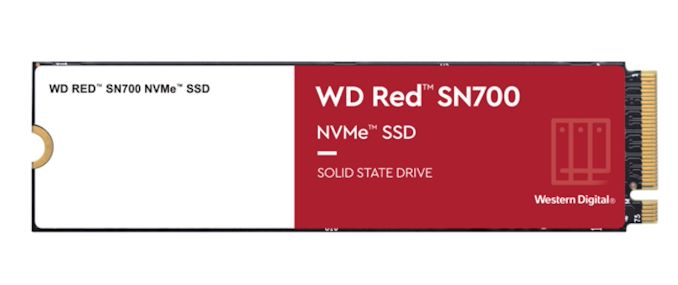Western Digital's Red series of drives for network-attached storage systems has a significant share in various NAS market segments. The series started off with a focus on hard drives, and more recently WD Red SSDs were introduced in Q4 2019, a few years after the SanDisk acquisition. These SATA SSDs (in both 2.5" and M.2 form-factors) were based on Marvell 88SS1074 controllers and targeted caching applications.
The increasing popularity of tiered storage, coupled with the deployment of NVMe (in the form of add-in cards, and now, natively in NAS boards) has prompted Western Digital to create a new member in the WD Red family. The new WD Red SN700 comes in 5 capacities ranging from 250GB to 4TB.
| WD Red SN700 NVMe SSDs for NAS | ||||||
| Capacity | 250 GB | 500 GB | 1 TB | 2 TB | 4 GB | |
| Model Number | WDS250G1R0C | WDS500G1R0C | WDS100T1R0C | WDS200T1R0C | WDS400T1R0C | |
| Controller | SanDisk In-House? | |||||
| NAND Flash | 3D TLC NAND | |||||
| Form-Factor Interface |
M.2-2280, PCIe 3.0 x4, NVMe 1.3 | |||||
| Single-Sided (22.15mm x 80.15mm x 2.38mm) |
Double-Sided (22.15mm x 80.15mm x 3.58mm) |
|||||
| Seq. Read Max (128KB @ QD32) |
3100 MBps | 3430 MBps | 3400 MBps | |||
| Seq. Write Max (128KB @ QD32) |
1600 MBps | 2600 MBps | 3000 MBps | 2900 MBps | 3100 MBps | |
| Rand. Read IOPS (4KB @ QD32) |
220K | 420K | 515K | 480K | 550K | |
| Rand. Write IOPS (4KB @ QD32) |
180K | 380K | 560K | 540K | 520K | |
| SLC Caching | Yes | |||||
| DRAM Buffer | ? | ? | ? | ? | ? | |
| Opal Encryption | ? | |||||
| Power | Peak | 9.24 W | ||||
| PS3 (LP) | 70 mW | 100 mW | ||||
| PS4 (Sleep) | 3.5 mW | 5 mW | ||||
| Warranty | 5 years | |||||
| MTBF | 1.75 million hours | |||||
| TBW | 500 | 1000 | 2000 | 2500 | 5100 | |
| DWPD | 1 | 0.7 | ||||
| Addl. Info. | Link | |||||
| MSRP | ? | ? | ? | ? | ? | |
A PCIe 3.0 x4 NVMe drive can provide a quantum leap in I/O performance, especially over pure HDD-based systems. NAS units are fast becoming hyperconverged application servers, and NVMe drives can improve user experience with both storage tasks as well as application tasks. In particular, tasks related to workloads like virtualization, multi-user collaborative editing and other similar applications. The benefits for traditional enterprise workloads such as intensive databases are also evident, even when the NVMe drive is used purely as a caching drive. Interestingly, the 1TB and lower capacity models have a 1 DWPD rating, while the 2TB and 4TB ones have a 0.7 DWPD endurance number.
It must be noted that Seagate has already released two generations of NVMe drives for the NAS market in their IronWolf series. WD is playing a bit of a catch-up in this particular market segment, but its SanDisk heritage and vertical integration can possibly give the WD Red SN700 an edge over the IronWolf series.
from AnandTech https://ift.tt/3ogE06O
via IFTTT

0 comments:
Post a Comment